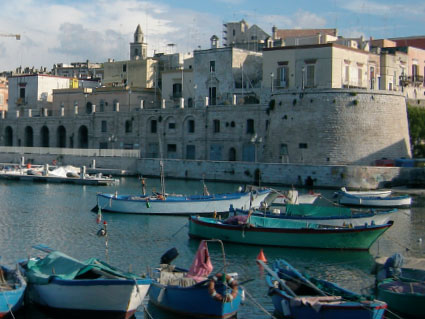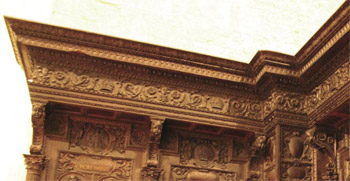





Well-founded accounts on the origins of the cult of the Virgin of Sorrows in the Concathedral Church of Bisceglie are recorded together with the Pastoral visit of the Bishop Mons. Gaetano de Franci in 1823. The Confraternity in his honour was founded many decades later in 1970.
A group of men, devout to Virgin Mary, formed a Confraternity in her honour; this replaced the Confraternity of SS. Martyrs and the Chapter, whose brothers had carried till that moment the Statue of Virgin Mary on Good Friday.
The aforesaid group of worshippers used to wear a black shirt and a scapular representing the Virgin. On Good Friday the procession leaves from the Concathedral, the sanctuary dedicated to the Virgin of Our Sorrows, moves across some churches and finally reaches the central Piazza Vittorio Emanuele, nearby the Calvario, at 9:30. Here there is the last “meeting” between the statue of Jesus Christ carrying the cross (this procession leaves from the Church of St. Lorenzo) and the statue of his mother, before dying on the Cross. This one of the most moving and poignant performance of popular faith in Apulia: this is a moment that believers wait with deep devotion. According to the tradition, after the meeting, the statues are carried again in procession following different routes across the churches where the sepulchre is exhibited. Only for this special and unique occasion the brothers carry the statue of the Virgin by arm rather than on shoulders. Even the dress the statues wears is different from the September rite: the pure and black silk of the simple dress expresses best the dolefulness of Good Friday. Another peculiar feature is the brothers’ cloth characterized by the absence of black. When the confraternity was founded they chose to wear a white gown and a white belt, with a cream coloured mozzetta trimmed with golden fringe representing the Virgin: such bright colours were chosen to symbolize the hope that arises from Jesus’ resurrection.

The Confraternity of St. Giuseppe was founded in 1072 by the order of friars minor devoted to St. Francesco and for the will of the Bishop Pompeo Sarnelli, in the church of St. Lorenzo, placed outside the town walls. Actually, the Confraternity had already existed long before 1072 and the brothers used to wear a white cotton tunic with a green and damask mozzetta with a shield portraying St. Giuseppe, and a green hat.
Nowadays the brothers wear a white tunic with a green shoulder belt and a shield portraying the Holy Family; only one model of the original hat is preserved by one of the brothers.
In 1781 the Royal family of Borbone awarded the Confraternity of St. Giuseppe as well as all the other confraternities.
Today the Confraternity is composed of about fifty devout brothers who meet all together every first Tuesday of the month for catechism.
They take care for the cult of their Saint protector, St. Giuseppe, and organize a
a three-day cycle of prayers before its liturgical ceremony on 19th March. Then, on this day dedicated to the Saint, Holy Masses are celebrated in the morning and in the evening. The celebrations are closed with the procession of the 18th century wooden statue followed by the musical band. On the Good Friday morning, the confraternity organizes also the procession of the statues of Jesus Christ carrying the cross. The 19th century wooden statue is kept in a niche situated at the end of the left-side nave in the church of St. Lorenzo. The statue was commissioned by the confraternity in order to worship Jesus Christ all year until the most painful moments of his passion.
The procession starts from the church of St. Lorenzo at about 9.oo in the morning to reach the statute of Our Lady of Sorrows half an housìr later in Piazza Vittorio Emanuele, nearby the Calvario.
The statue of Christ is carried in the brothers’ shoulders accompanied by the funeral marches and surrounded by a huge crowd of worshipers deeply moved.
The most important and moving moment of such rite is the breathtaking kiss between the Son and His Mother.
According to the tradition, after the meeting, the statues are carried again in procession following different routes across the churches where the sepulchre is exhibited. Finally, they are carried back to their churches at 2 p.m.